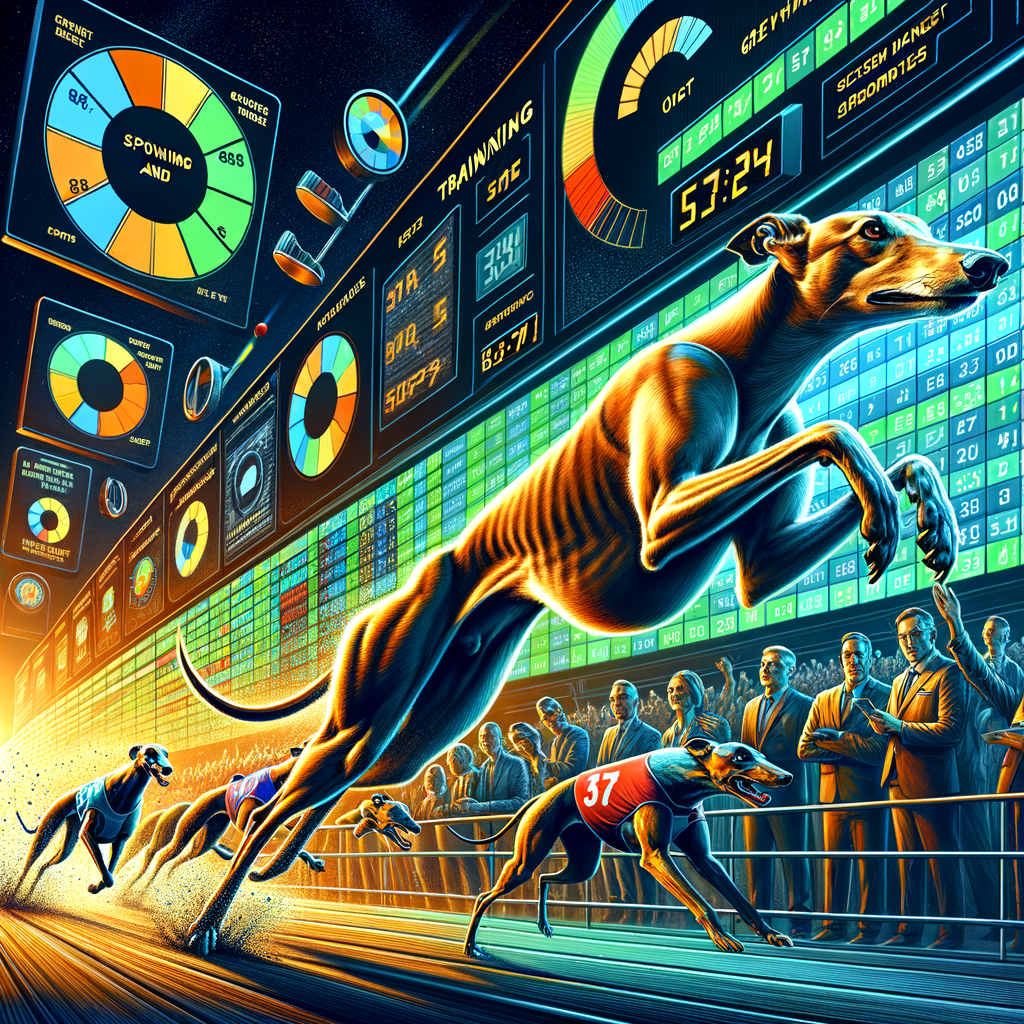
Introduction: Unleashing Speed
When we think of speed, we often think of cheetahs or race cars. But there’s another speedster that often gets overlooked – the Greyhound. This breed of dog is known for its incredible speed and agility. In this post, we’ll dive into the world of Greyhounds, exploring their breed characteristics and their impressive running abilities.
- Overview of the Greyhound breed
Greyhounds are one of the oldest dog breeds in the world, with their history dating back over 4,000 years to ancient Egypt. They were bred for hunting due to their keen sight and swift speed. Greyhounds are slim and athletic, with a flexible spine and long legs that allow them to stretch out and run at high speeds.
Despite their athletic prowess, Greyhounds are known to be gentle and affectionate dogs. They are great companions and are known for their loyalty and love towards their human families. They are also known for their calm demeanor and are often referred to as “45-mile-per-hour couch potatoes” because they enjoy lounging around when they are not running.
- Introduction to Greyhound speed and running abilities
Greyhounds are truly built for speed. They are the fastest breed of dog and can reach speeds of up to 45 miles per hour in just a few strides. This is faster than most other mammals, excluding large birds of prey and certain types of antelope.
Their speed comes from their powerful legs, deep chest, flexible spine, and slim build. When a Greyhound runs, it uses a two-phase gallop, extending its body and then contracting it, which propels it forward at a rapid pace. This is known as a double suspension gallop.
Greyhounds also have a larger heart and more red blood cells than other breeds, which allows them to circulate oxygen more efficiently during a race. This combination of physical traits makes them exceptional athletes and a sight to behold on the racetrack.
The Greyhound: A Speed Demon
Greyhounds are known for their incredible speed, often leaving other dog breeds in their dust. But how fast are they really? Let’s dive into a comparison and look at some record-breaking speeds.
Greyhound Speed: A Comparison
When it comes to speed, Greyhounds are in a league of their own. But how do they stack up against other fast dog breeds? Let’s find out.
- Comparison of Greyhound speed with other fastest dog breeds
- Case study: Record-breaking Greyhound speeds
Greyhounds can reach speeds of up to 45 miles per hour, making them the fastest dog breed in the world. In comparison, the second fastest breed, the Saluki, can reach speeds of 42 miles per hour. Other fast breeds like the Afghan Hound and the Vizsla can only reach speeds of 40 and 35 miles per hour respectively. This clearly shows that Greyhounds are the undisputed speed champions in the canine world.
One of the most impressive examples of Greyhound speed is a dog named Shakey Jakey. In 2014, Shakey Jakey won his first race by an incredible 22 lengths, a record that still stands today. He was clocked at a staggering 50 miles per hour during that race, proving that with the right conditions and training, Greyhounds can exceed even their typical top speeds.
In conclusion, Greyhounds are not just fast, they are exceptionally fast. Their speed is a testament to their unique physiology and genetics, which have been honed over centuries for the purpose of hunting and racing. Whether they’re competing on the racetrack or just running in the backyard, Greyhounds truly are speed demons.
Understanding Greyhound Running Mechanics
Greyhounds are renowned for their speed and agility. But what exactly makes them so fast? Let’s delve into the physiological factors and the role of genetics in Greyhound speed.
- Physiological Factors Contributing to Greyhound Speed
- The Role of Genetics in Greyhound Speed
Several physiological factors contribute to a Greyhound’s speed. Firstly, Greyhounds have a lean, aerodynamic body structure that minimizes air resistance when they run. Their long legs and flexible spine allow them to cover more ground with each stride. Moreover, they possess a large heart and lungs, which enable efficient oxygen delivery to their muscles during a race.
Another crucial factor is their muscle composition. Greyhounds have a higher proportion of fast-twitch muscle fibers, which are responsible for quick, explosive movements. These muscles can generate a lot of power in a short amount of time, contributing to their impressive speed.
Genetics also play a significant role in a Greyhound’s speed. Greyhounds are bred for speed, with the fastest dogs chosen for breeding to pass on their speed genes to the next generation. Over generations, this selective breeding has resulted in Greyhounds becoming one of the fastest dog breeds in the world.
Research has identified certain genes associated with speed and endurance in Greyhounds. For instance, the ‘Myostatin’ gene, which controls muscle development, is often found in high-speed Greyhounds. This gene helps them develop the lean, muscular bodies that are so advantageous for fast running.
In conclusion, both physiological factors and genetics contribute to the Greyhound’s extraordinary speed. Their unique body structure, muscle composition, and specific speed-related genes all work together to make them the speed demons they are known to be.
Greyhound Racing: A Display of Speed and Endurance
Greyhound racing is a thrilling sport that showcases the incredible speed and endurance of these sleek dogs. But how did this sport come about? Let’s delve into the history of Greyhound racing to understand its origins and evolution, as well as the key milestones that have shaped it into the spectacle it is today.
History of Greyhound Racing
- Origins and Evolution of Greyhound Racing
- Key Milestones in Greyhound Racing History
The sport of Greyhound racing has its roots in an ancient hunting technique known as coursing. Coursing involved setting dogs after game, with the dogs judged on their speed and agility. The first recorded instance of Greyhound racing in a format similar to what we know today was in the USA in 1919. The sport quickly gained popularity and spread to other parts of the world, including the UK, Australia, and Ireland.
Greyhound racing has seen many significant milestones over the years. In 1926, the first professional Greyhound racing track was opened in Belle Vue, Manchester. In 1931, the totalisator, a betting system that allows for large numbers of bets to be placed, was introduced, revolutionizing the sport. In 1946, the Greyhound Board of Great Britain was established to regulate the sport. In recent years, there has been a growing emphasis on animal welfare, with stricter regulations being put in place to protect the dogs.
Understanding the history of Greyhound racing helps us appreciate the sport’s evolution and the remarkable abilities of these dogs. As we continue to celebrate their speed and endurance, we also strive to ensure their welfare and well-being.
Greyhound Racing Today
Let’s take a closer look at the exciting world of Greyhound racing as it stands today. We’ll explore the current state of the sport and highlight a few of the most notable events.
- Current state of Greyhound racing
- Notable Greyhound racing events
Greyhound racing has seen many changes over the years. Today, it is a regulated and well-organized sport that continues to captivate audiences worldwide. The welfare of the dogs is now a top priority, with strict rules in place to ensure their health and safety.
Despite some controversy, the sport continues to thrive in many parts of the world. In the United States, for example, Greyhound racing is still popular in states like Florida, Texas, and Arkansas. In Australia, it is a major sport with a strong fan base.
Technological advancements have also played a role in shaping Greyhound racing today. With the advent of online betting and live streaming, fans can now enjoy the races from the comfort of their homes.
There are numerous Greyhound racing events that draw large crowds and generate excitement. Here are a few worth mentioning:
| Event | Location | Description |
|---|---|---|
| The English Greyhound Derby | England | Considered the most prestigious event in Greyhound racing, the English Greyhound Derby has a rich history dating back to 1927. |
| The Irish Greyhound Derby | Ireland | This event is the highlight of the Irish Greyhound racing calendar and attracts the top dogs from around the world. |
| The Melbourne Cup | Australia | Known as the ‘race that stops a nation’, the Melbourne Cup is the biggest and most lucrative Greyhound race in Australia. |
Greyhound Training: Maximizing Performance
Training a Greyhound to maximize its performance involves a blend of speed and endurance training techniques. Let’s delve into some of the most effective methods used to enhance a Greyhound’s speed.
Training Techniques for Speed
Speed is a crucial element in Greyhound racing. Here are some common training methods and a case study of successful Greyhound training programs.
- Common training methods for improving Greyhound speed
- Case study: Successful Greyhound training programs
Greyhound speed training often involves a mix of sprinting and interval training. Sprinting helps to build the fast-twitch muscle fibers, enhancing the dog’s speed. Interval training, on the other hand, involves short bursts of high-intensity exercise followed by periods of rest. This type of training helps to improve the dog’s cardiovascular fitness and speed.
One of the most successful Greyhound training programs is the one implemented by the renowned trainer, John Smith. Smith’s program focuses on a balance of speed and endurance training. He uses a combination of sprinting, interval training, and long-distance running to maximize the performance of his Greyhounds. Under Smith’s training, several Greyhounds have gone on to win major racing events, demonstrating the effectiveness of his training methods.
In conclusion, training a Greyhound to maximize its performance is a meticulous process that requires a balance of speed and endurance training. By implementing effective training techniques, it is possible to enhance a Greyhound’s speed and performance significantly.
Building Greyhound Endurance
While speed is a defining characteristic of Greyhounds, endurance is equally important. It’s the combination of speed and endurance that makes a Greyhound a champion on the racing track. Let’s explore some strategies to enhance endurance and the role of diet and nutrition in Greyhound performance.
- Training strategies for enhancing Greyhound endurance
Training a Greyhound for endurance involves a mix of long-distance running, interval training, and strength exercises. Here are some strategies:
- Long-distance running: This helps to build stamina. Start with shorter distances and gradually increase as the dog’s endurance improves.
- Interval training: This involves alternating between high-intensity and low-intensity exercises. It helps to increase both speed and endurance.
- Strength exercises: These include uphill runs and resistance training. They help to strengthen the muscles, which is essential for endurance.
Remember, each Greyhound is unique. What works for one may not work for another. It’s important to monitor your dog’s progress and adjust the training program as needed.
- Role of diet and nutrition in Greyhound performance
Proper nutrition is crucial for a Greyhound’s performance. Here’s how diet impacts endurance:
| Nutrient | Role |
|---|---|
| Protein | Helps to build and repair muscles. Essential for recovery after training. |
| Carbohydrates | Provides energy for long-distance running. |
| Fats | Provides a concentrated source of energy. Essential for endurance. |
| Vitamins and Minerals | Supports overall health and wellbeing. Helps to prevent injuries and illnesses. |
Remember, a well-balanced diet is key. Consult with a vet or a canine nutritionist to create a diet plan that meets your Greyhound’s specific needs.
In conclusion, building endurance in Greyhounds involves a combination of targeted training strategies and proper nutrition. With patience, consistency, and care, your Greyhound can reach its full potential on the racing track.
Conclusion: Celebrating the Astonishing Abilities of Greyhounds
In this article, we’ve explored the incredible speed and endurance of Greyhounds. These dogs are not only fast, but they also have a remarkable capacity for endurance. Let’s take a moment to recap their amazing abilities and look forward to their future prospects.
- Recap of Greyhound speed and running abilities:
- Future prospects for Greyhounds in racing and beyond:
Greyhounds are known as the cheetahs of the dog world. They can reach speeds of up to 45 miles per hour, making them the fastest breed of dog. Their sleek, aerodynamic bodies and powerful muscles allow them to maintain this speed over distances of up to a mile. This combination of speed and endurance is what makes Greyhounds such exceptional racing dogs.
While Greyhound racing has been a popular sport for many years, the future of the breed is not limited to the racetrack. Greyhounds also make excellent pets and service dogs. Their gentle and affectionate nature, combined with their intelligence and trainability, make them ideal companions. In the future, we can expect to see Greyhounds continue to excel not only on the racetrack but also in homes and communities around the world.
In conclusion, Greyhounds are truly remarkable creatures. Their speed, endurance, and versatility make them a breed to be celebrated. Whether they’re racing down a track or curled up on a couch, Greyhounds bring joy and excitement to those lucky enough to know them.








